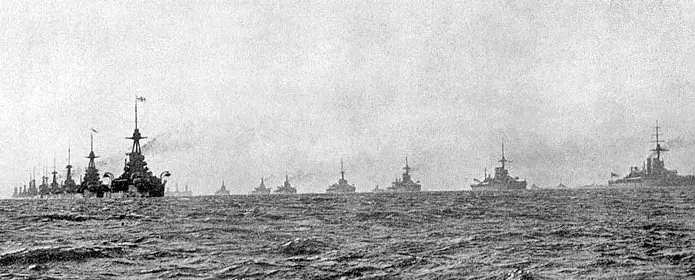HMS Caroline : Wiki Commons
The HMS Caroline, a WW1 C Class light Cruiser of the British Royal Navy and last remaining survivor of the Battle of Jutland is under threat from the scrap heap, destined for a future as razor blades.
Launched in 1914, she retained the status of being the second oldest ship in royal naval service at the time of being decommissioned in 2011, second only to the HMS Victory as well as being the last First World War British light cruiser in service.
Until recently, she served as the static headquarters and training ship for the royal naval reserve in the Alexandra Dock, Belfast.
Plans to scrap the ship for its raw metals have been proposed for August 1, unless initial estimates of £5 million in restorations, along with a yearly £250 maintenance fee can be raised to ensure the survival of this historic monument to WW1 naval warfare.
Part of the proposal to ensure the future of the Caroline, is to develop the ship into a floating tourism attraction in addition to promoting for corporate events. Almost 80% of the ship remains in its original condition, with 400 artefacts currently in storage that could be returned if the ship can be saved.

Maritime historian and former alliance leader Sean Seeson from the National Historic Ships Committee stated: “It is important that we move quickly on the issue to make sure that Caroline remains in Belfast,”
“We would be appealing to the Stormont Executive to consider the importance of retaining the vessel. I believe the ship could be saved if there was cross-departmental co-operation, as has happened in the case of the SS Nomadic.”
A DETI – Department of Trade and Investment spokeswoman said: “The department has been working for some time now to find the best solution for HMS Caroline and has met with various stakeholders who are also keen to have HMS Caroline retained in Belfast.
Seeped in history, the Caroline was part of the Royal Navy’s Grand fleet (& now the last surviving member) that fought in the Battle of Jutland on the 31st May and 1st June in 1916. The battle comprised of the Imperial German Navy’s High Seas Fleet and Royal Navy’s Grand Fleet, comprising of 250 ships.

It was the largest naval battle and the only full-scale clash of battleships in the war. It was only the third-ever fleet action between steel battleships, following the smaller but more decisive battles of the Yellow Sea (1904) and Tsushima (1905) during the Russo-Japanese War.
During the Second World War Caroline served as the Royal Navy’s headquarters in Belfast Harbour which was used as a home base by many of the warships escorting Atlantic and Russian convoys including Captain-class frigates of the 3rd Escort Group.
Caroline retains the record of having the fastest build time of any significant warship – nine months from her keel being laid till her launch. Her Parsons steam turbines are the last surviving examples of the kind introduced after the notable event of Parson’s Turbinia cutting up the fleet at the Spithead review in 1897.
At the time of her decommission the commanding officer Martin Quinn said: “The Royal Navy’s preference would be to leave her here in Belfast. What we see is the ship being part of a maritime heritage trail created with local government and local authorities.”
HMS Caroline is part of the National Historic Fleet, Core Collection. Contact the Mortimer Team, a campaigning mouthpiece for heritage, archaeology and the environment to discuss how we can fight to save this national treasure. Mortimer : [email protected]
Contributing Source : WikiPedia
HeritageDaily : Archaeology News : Archaeology Press Releases




